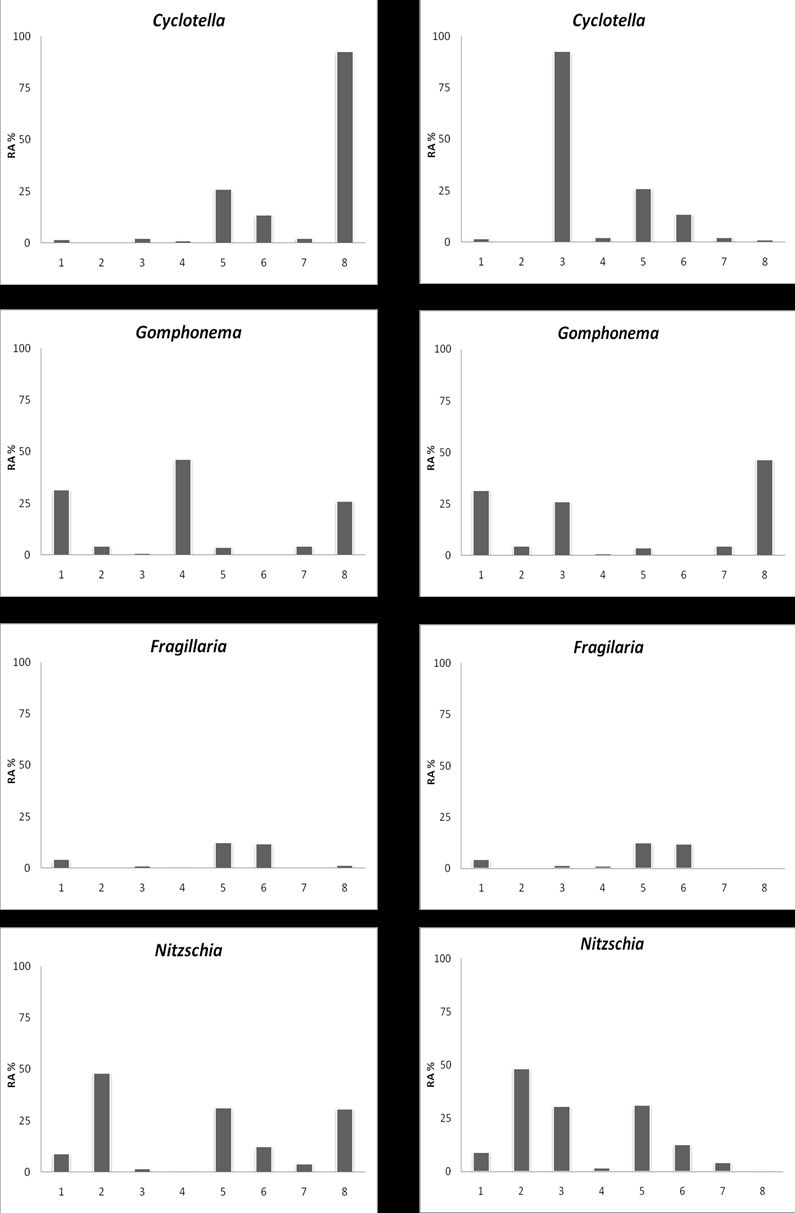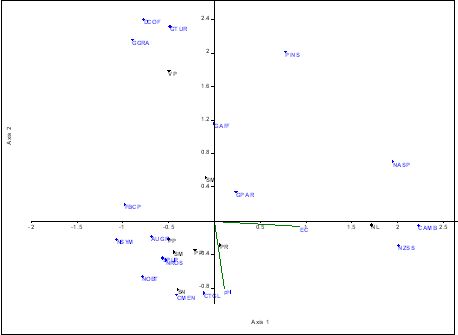Results and Discussion
Water Quality and Diatom Community
Physical variables of water such as pH, temperature, electric conductivity (EC), salinity and total dissolved solids (TDS) are listed in Table 2. pH ranges from 7.4 to 9 indicating neutral to alkaline conditions. Electric conductivity ranges from 280 (Vedapatti) - 2250µScm-1 (Singanallur). Diatom analysis reveals that 96 species belonging to 34 genera were recorded from these wetlands, which are listed in Annexure-I. Among all species, 27 species were dominant (i.e., occurring >5% of any given community). Table 3 lists the diversity indices, which shows a significant difference in community structures across the wetlands. Higher values of Shannon, Simpson and Evenness values are recorded for Pallapalayam wetland (PP) compared to Singanallur wetland (SN), where Dominance index was relatively higher.
Table 2: Water Quality Variables of Coimbatore Wetlands
| Sampling site | Conductivity (µS/cm) | Water Temperature (˚C) | pH | Total Dissolved Solids (mg/L) |
| Vedapatti | 280 | 29.6 | 7.47 | 195 |
| Sundakamuthur | 283 | 32.4 | 9.06 | 198 |
| Sundakamuthur | 283 | 32.4 | 9.06 | 198 |
| Perur | 347 | 29 | 7.92 | 242 |
| Pallapalayam | 733 | 27.9 | 9.05 | 511 |
| Pallapalayam | 770 | 29.3 | 8.83 | 543 |
| Noyyal River | 1121 | 29.7 | 7.7 | 781 |
| Singanallur | 2250 | 29.3 | 8.53 | 1590 |
Table 3: List of Diversity indices for Coimbatore wetlands
| VP | PP | SM | PP | SN | PR | SM | NL | |
| Number of species | 23 | 22 | 29 | 26 | 10 | 28 | 30 | 14 |
| Shannon Index | 2.371 | 2.498 | 2.066 | 2.621 | 0.4135 | 2.366 | 2.538 | 1.472 |
| Simpson | 0.8526 | 0.8877 | 0.7276 | 0.8764 | 0.1402 | 0.8545 | 0.874 | 0.6768 |
| Evenness | 0.4654 | 0.5529 | 0.2723 | 0.5289 | 0.1512 | 0.3805 | 0.4217 | 0.3114 |
| Margalef | 3.649 | 3.453 | 4.66 | 4.161 | 1.496 | 4.56 | 4.973 | 2.016 |
| Equitability | 0.756 | 0.8083 | 0.6137 | 0.8045 | 0.1796 | 0.71 | 0.7461 | 0.5579 |
| Fisher alpha | 5.247 | 4.88 | 7.143 | 6.189 | 1.85 | 7.013 | 7.927 | 2.536 |
| Berger-Parker | 0.306 | 0.1986 | 0.4963 | 0.2604 | 0.9268 | 0.2547 | 0.2317 | 0.4596 |
Common diatoms genera such as Cyclotella Kützing ex Brébisson, Gomphonema Ehrenberg, Nitzschia Hassalland Fragilaria Lyngbyeaccounted for large proportion of the community in all sites. Figure 2, a plot of genera across pH and Electrical conductivity ranges revealed the following observation, a) Cyclotella sp. occurs in neutral to high alkaline and high electrolytic, b) Gomphonema sp. and Nitzschia sp. occurs in entire pH and conductivity ranges and c) Fragilaria sp. prefers neutral to alkaline pH and moderate electrolytic water.

Figure 2: Relative abundance of four most dominant genera plotted with sites arranged in order of increase in electrical conductivity (left) and pH (right).
Diatom assemblages and trophic condition
Distribution of diatom reflects the average ecological conditions of water (Cholnoky 1968; Lowe 1974). In Vedapatti wetland, cosmopolitan extreme pollution resistant species Diadesmis confervaceae Kützing, Gomphonema gracile Ehrenberg and G.turris Ehrenberg were dominant among 23 species highlighting eutrophic status of water with higher electrolyte. Aulocosira granulata (Ehrenberg) Simonsenand Cyclotella meneghiniana Kützingare dominant among 22 species in the epilithic substrata and 26 species in epiphytic substrata of Pallapalayam wetland. These species are cosmopolitan in distribution in both benthic and plankton representing electrolyte rich and brackish inland water. Episammic sample from Sundakamuthur is dominated by Sellaphora pupula (Kützing) Mereschkowksy and Navicula rostellata Kützing, which are more tolerant to high levels of pollution. Epiphytic sample is represented by Gomphonema parvulum Kützing var. parvulum f. parvulum and G. affine Kützing, which are tolerant to extreme pollution and occurs in water with elevated electrolyte. Cyclotella meneghiniana, a cosmopolitan species, resistant to extreme pollution with wide range of distribution including eutrophic, electrolyte rich water, accounts for more than 90% of the 10 species in Singanallur wetland. Perur wetland with 28 species has Cymbella turgida Grunow in A.Schmidt & al., Gomphonema parvulum, Nitzschia clausii Hantzsch and N. obtusa W.M.Smith as dominant species. Gomphonema parvulum and Nitzschia sp. survive even extreme pollution in wetlands whereas Cymbella turgida Gregory thrive in mesotrophic to eutrophic condition. The assemblages of Noyyal river is similar as in Perur wetland, where this site is represented by Aulocosira granulata, Craticula ambigua (Ehrenberg) Mann, Gomphonema parvulum and Nitzschia sp. more in number. Aulocosira granulata and Craticula ambigua thrive in mesotrophic to eutrophic conditions and Gomphonema and Nitzschia sp. are capable of surviving even in extreme conditions of pollution. Noyyal River, Pallapalayam and Sundakamuthur wetlands were dominated by Gomphonema sp. Nitzschia sp. Aulocosira granulata, Cyclotella meneghiniana and Sellaphora pupula. These wetlands receive untreated sewage and are eutrophic to mesotrophic evident from diatom assemblages.
Canonical correspondence analysis (CCA)
CCA tri-plot explains the distribution of species across sampling sites (Figure 3). The species abbreviations used in the CCA diagram may be found in Annexure-I. Among water quality variables, physical variables such pH and electric conductivity were included in the CCA analysis because of the variation across sampling sites. Ordination axis 1 explains gradient in site distribution with Gomphonema parvulum, Nitzschia species, Navicula species and Craticula ambigua as more abundant, showing tolerance for conductivity (EC) at Singanallur lake and Sundakamuthut lake. Axis 2 describes impact of alkaline pH on species such as Cyclotella meneghiniana at Singanallur lake and pallapalayam with Aulocoseira granulata, while Nitzschia obtuse W.M.Smith; Sellaphora pupula at Sundakamathur and Cymbella turgidula Grunow at Perur. Vedapatti is less influenced by pH and conductivity while the dominant Diadesmis confervaecae Kützing reveals organically polluted water condition.

Figure 3: CCA triplot showing relationship between environmental variables and diatom species in the Coimbatore wetlands. Acronyms of species are listed in Annexure-I.
Diatom Indices
The diatom indices calculated to evaluate water quality is listed in Table 4. IPS, GDI and TDI indices attributing to trophic status are listed in Table 5 (adopted from Eloranta & Soininen, 2002, Taylor, 2004). The TDI scores (Table 5) ranged from 76 to 99.9 indicating bad water quality with an increasing level of pollution or eutrophication in all wetlands. Dominant diatom assemblage specific to substrata along with water quality class and trophic conditions of the wetlands are listed in Table 6.
Table 4: Diatom Indices values for the wetlands
| SITES | IPS | SLAD | DESCY | L&M | SHE | WAT | EPI-D | ROTT | IDG | CEE | IBD | IDAP | TDI |
| VP | 7.7 | 13.2 | 17.3 | 11.1 | 14 | 8.5 | 10.9 | 16.3 | 12.8 | 11.6 | 1 | 11.6 | 84.3 |
| PP | 7.3 | 10.3 | 11.3 | 9.6 | 13.4 | 10.6 | 7.6 | 8.3 | 10.1 | 4.6 | 6.1 | 7.2 | 92.5 |
| SM | 9.3 | 10.6 | 9.8 | 9.3 | 13 | 6.2 | 8.1 | 11.3 | 10 | 8.4 | 8.1 | 7.2 | 76 |
| PP | 7.6 | 10.1 | 11.1 | 9.3 | 13.4 | 10.2 | 7.9 | 12.7 | 11.9 | 3.7 | 6.6 | 7.2 | 90.3 |
| SN | 5.9 | 7.8 | 10.4 | 8.2 | 8.9 | 1.7 | 8.1 | NA | 13.5 | 3.3 | 6.5 | 5.8 | 99.9 |
| PR | 13.5 | 10.1 | 11.7 | 9.1 | 6.1 | 13.6 | 8.3 | 10.7 | 12.3 | 6.3 | 15.8 | 6.7 | 77.9 |
| SM | 9.8 | 10.5 | 9.9 | 8.5 | 8.6 | 10.7 | 8.3 | 11 | 12.2 | 8.2 | 7.7 | 4.9 | 86.3 |
| NL | 8 | 9.2 | 9.8 | 7.8 | 9.6 | 10.9 | 8.9 | 3.8 | 6 | 5.2 | 3.9 | 7.2 | 81.3 |
Note: VP- Vedapatti wetland (epiphytic); PP- Pallapalayam wetland (epilithic); SM- Sundakamuthur wetland (episammic); PP-Pallapalayam wetland (epiphytic); SN-Singanallur wetland (epiphytic); PR-Perur wetland (epiphytic); SM- Sundakamuthur wetland (epiphytic); NL-Noyyal River (epiphytic). Refer Table 1 for details about the diatom indices
Table 5: Class limit values for Diatom indices (Eloranta & Soininen, 2002)
| Class no. | Index score | Class | Trophy |
| 1 | >17 | High quality | Oligotrophy |
| 2 | 15 to 17 | Good quality | Oligo-mesotrophy |
| 3 | 12 to 15 | Moderate quality | Mesotrophy |
| 4 | 9 to 12 | Poor quality | Meso-eutrophy |
| 5 | <9 | Bad quality | Eutrophy |
Table 6: Trophic condition of the wetlands with dominant species
| Site name | Dominant Species | Substrata | Class | Water quality | Trophic conditions |
| Vedapatti wetland (VP) | Diadesmis confervaceae, Gomphonema turris, G. Gracile | Aquatic plant | 3-4 | Moderate to poor quality | Meso-eutrophic to mesotrophic |
| Pallapalayam wetland (PP) | Aulocosiera granulata, Nitzschia sp., Cyclotella meneghiniana | Stone | 3-5 | Moderate to bad quality | Mesotrophic to eutrophic |
| Sundakamuthur wetland (SM) | Sellaphora pupula, Navicula rostellata | Sediment | 4-5 | Bad quality | Eutrophic |
| Pallapalayam wetland (PP) | Cyclotella meneghiniana, Aulocosira granulata | Aquatic plant | 3-5 | Moderate to bad quality | Mesotrophic to Eutrophic |
| Singanallur wetland (SN) | Cyclotella meneghiniana | Aquatic plant | 5 | Bad quality | Eutrophic |
| Sundakamuthur wetland (SM) | Sellaphora pupula, Gomphonema parvulum, Gomphonema sp. | Aquatic plant | 4-5 | Bad to poor quality | Eutrophic |
| Perur wetland (PR) | Gomphonema parvulum, Cymbella turgida, Nitzschia obtusa, Nitzschia clausii | Aquatic plant | 4 | Moderate to Poor quality | Meso-eutrophic |
| Noyyal River (NL) | Nitzschia sp., Navicula sp. | Aquatic plant | 4-5 | Bad to poor quality | Meso-eutrophic |
Habitat preference
Diatom community structure varied very distinctly across the habitats. Epiphytic, Epilithic and Episammic habitats contained 50%, 10.4%, and 7.2% of taxa respectively, unique to that habitat. In all these habitats, Gomphonema affine, G. parvulum, Aulocosira granulata and Navicula rostellata Kützing were common, while G. parvulum and A. granulata were abundant. Annexure: 2 list species with their habitats indicating majority of the diatom species as epiphytic. Diatoms specific to epilithic habitats are Fragilaria ungeriana Grunow, Thalassiosira duostra Peinaar, Navicula anthracis Cleve et Brun, Eolimna subminuscula (Manguin) Moser Lange-Bertalot & Metzeltin, Amphora veneta Kützing, Navicula veneta Kützingand Nitzschia sigma (Kützing) W.M.Smith. Epilithic habitat supports both centric and pennate diatoms. Episammic habitat supported 10 species which includes Navicula viridula (Kützing) Ehrenberg, Aulacoseira muzzanensis (Meister) Krammer, Gomphonema pseudoaugar Lange-Bertalot, Hantzschia Grunow, Anomoeoneis sphaerophora (Ehr.) Pfitzer, Pinnularia microstauron (Ehr.) Cleve, P. Graciloides Hustedt, P. Interrupta W.M.Smith, Caloneis bacillum (Grunow) Krammerand Rhopalodia Müller, Cyclotella meneghiniana and Nitzschia obtusa were most abundant and specific to epiphytic and epilithic substrata. Similarly, species with average dominance were restricted to only epiphytic and episammic habitats. However, diatom community specific to both epilithic and episammic were absent.
| * Corresponding Author : | |||
| Dr. T.V. Ramachandra Energy & Wetlands Research Group, Centre for Ecological Sciences, Indian Institute of Science, Bangalore – 560 012, INDIA. Tel : 91-80-23600985 / 22932506 / 22933099, Fax : 91-80-23601428 / 23600085 / 23600683 [CES-TVR] E-mail : cestvr@ces.iisc.ac.in, energy@ces.iisc.ac.in, Web : http://wgbis.ces.iisc.ac.in/energy |
|||